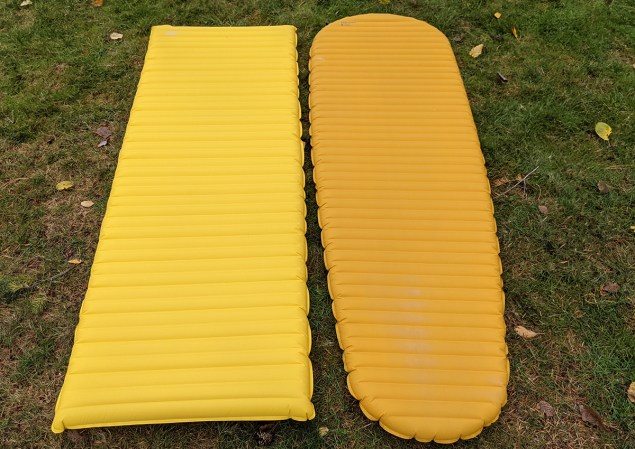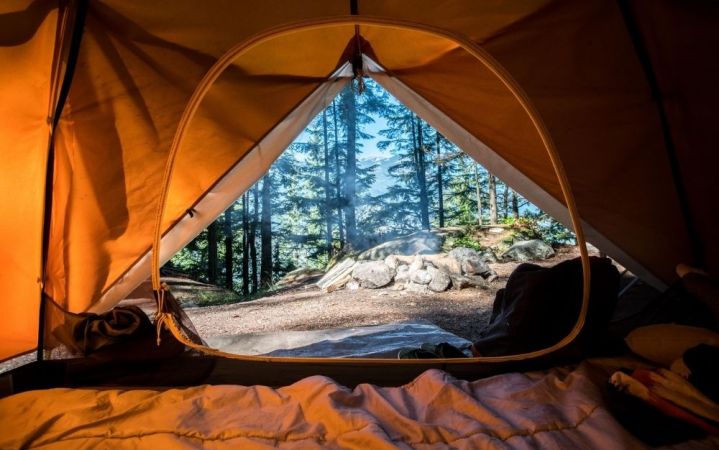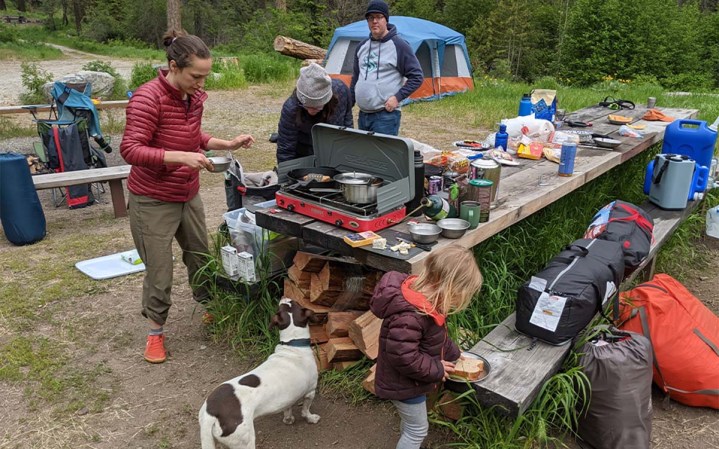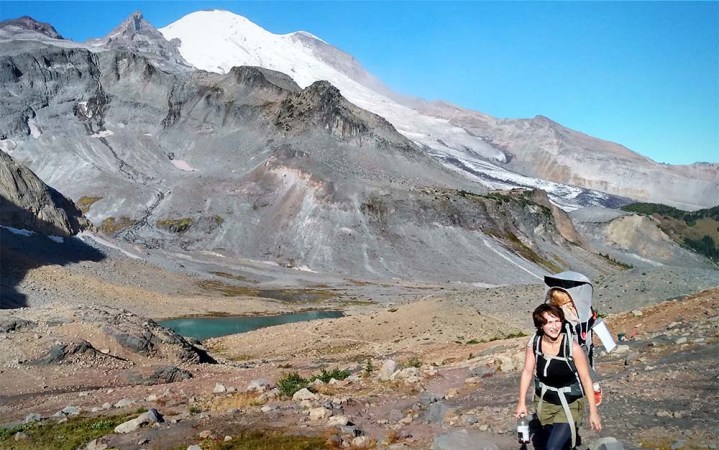We may earn revenue from the products available on this page and participate in affiliate programs. Learn More ›
As the backpacking and camping gear staff writer for Outdoor Life, I get asked for warm sleeping bag recommendations pretty regularly. But when I ask people about their gear, their current sleeping bag is usually warm enough. Their sleeping pad on the other hand? That’s the culprit. While most people think of inflatable sleeping pads as something that’s there to keep them comfortable, its real job is to protect you from the cold of the ground. If your sleeping pad isn’t up to snuff it can compromise the warmth of your sleeping bag by more than 20 degrees.
What is R Value?
Sleeping pads are assigned an R (for resistance) rating that measures how well they prevent the cold of the ground from creeping through to the side you are sleeping on. Low R values provide little to no resistance while high R values resist even subfreezing temperatures.
How R Value Affects Your Sleeping Bag’s Temperature Rating
REI ran hundreds of tests to better understand how the R value of a sleeping pad affects the temperature rating performance of a sleeping bag (or “sleep system” as REI refers to it), in different temperature conditions. They shared a small slice of the results with Outdoor Life, and it is striking.
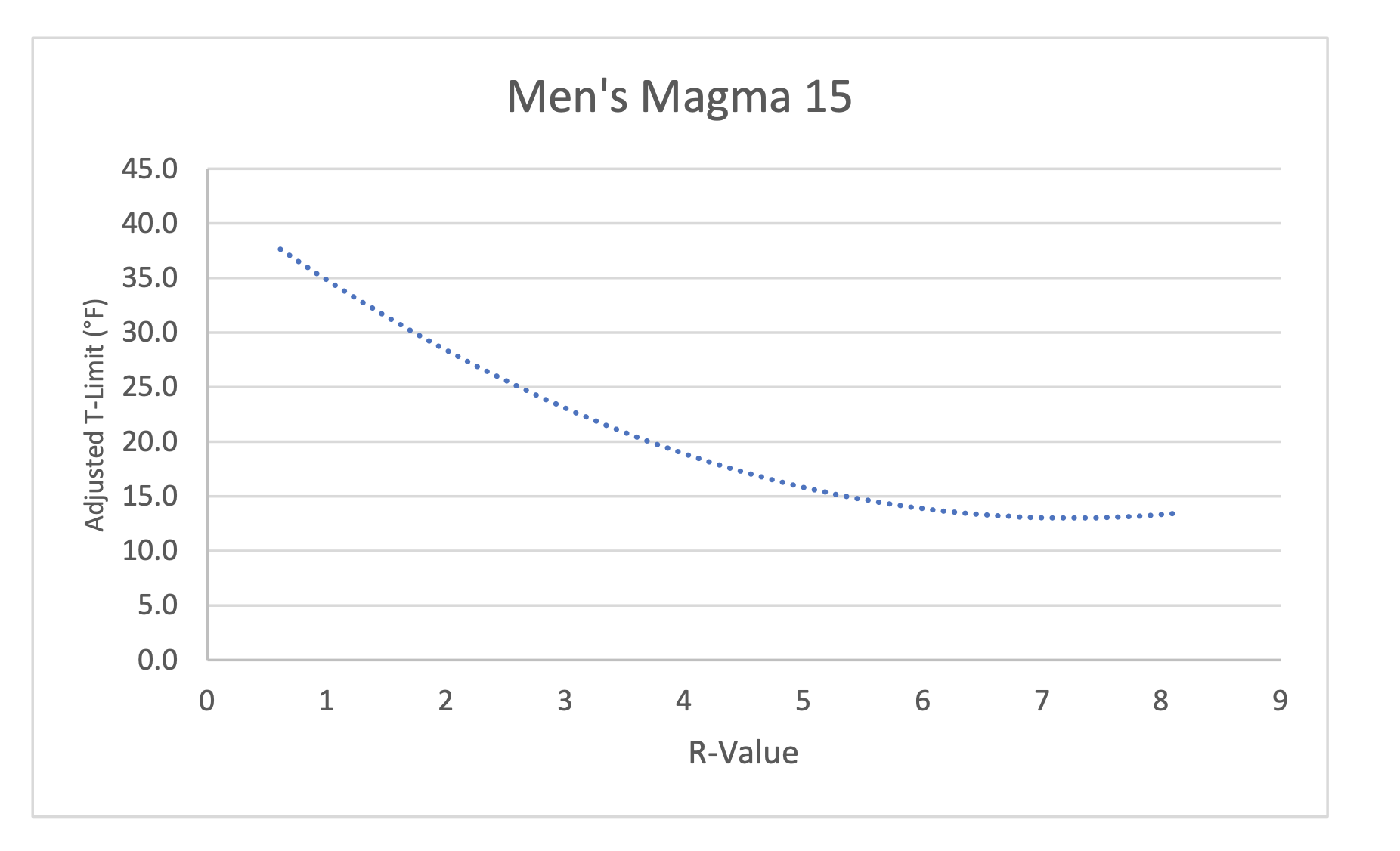
In the data they shared, REI used their men’s Magma 15 sleeping bag, which has an ISO limit rating of 16 degrees. The X axis shows the R value of the sleeping pad it’s paired with in the testing scenario, and the Y axis shows the adjusted temperature rating. When this 16-degree sleeping bag is paired with air-only inflatable pads (such as the Sea to Summit Ultralight Air or the Klymit Static V2), you end up with a 33-degree sleeping bag. With an R value of 2 (typical of closed-cell foam pads like the Therm-a-Rest Z Lite Sol and NEMO Switchback), you get a 28-degree sleeping bag. If you use standard insulated pads with an R value close to 4 (e.g., NEMO Tensor Ultralight and Big Agnes Rapide), you have a 19-degree bag.
The REI Magma 15 doesn’t become a true 16-degree sleeping bag until it’s paired with a sleeping pad that has an R value around 5. (You could expect a similar effect with other ISO-rated bags.) Note that this test only shows the effect of different R values on a 16-degree sleeping bag, but you could expect the results to be more extreme in colder conditions, and less extreme in warmer conditions.
Real Life Examples
That data is telling, but how does it relate to real life conditions? I used the Therm-a-Rest NeoAir Xtherm, which has an unusually high R value: 7.3, as a test subject to gather feedback on how a warmer sleeping pad affects the overall warmth of a sleeping bag. While that pad is possibly overkill for most people, it is the go-to choice for Jac “Top Shelf” Mitchell after 11,000 miles of backcountry trekking.
Three self-identified cold sleepers paired the Xtherm with their current sleeping bags to see how it affected their experience.
- Test Subject 1: Backpacker using a 30-degree Marmot mummy bag in low 40-degree overnight temperatures. Prior pad was an older Therm-a-Rest ProLite (R value of 2.4)
- Test Subject 2: Backpacker using a 40-degree Montbell mummy bag in upper 40-degree overnight temperatures. Previous pad was the Therm-a-Rest Uberlite (R value of 2.3)
- Test Subject 3: Car camper using a cot (no assigned R value) with a Walmart sleeping bag in low 50-degree overnight temperatures
The two backpackers were unequivocal that switching to the Therm-a-Rest Xtherm made an impressive difference in the overall warmth of their sleep system. One described it as feeling as if it “already radiated heat” from the moment she got on it, saying it was the first time in years she had slept without her puffer jacket on. Another stated that she didn’t even realize that she had been cold because of her sleeping pad until she tried the Xtherm. The car camper experimented with a larger system overhaul, trying out adding the Xtherm to her current setup, using a high-quality sleeping bag (the NEMO Forte) with just the cot, and then using both the high-quality sleeping bag and the Xtherm together. She reported back that she needed both the high-quality sleeping bag and the high R-value sleeping pad to stay warm through the night, even on a cot.
Interestingly, even though the two backpackers had been using R-rated pads in line with current recommendations (sleeping pads with an R value of 2 are typically recommended for 50-degree weather), they found that leveling up to the Xtherm made a substantial difference in the warmth of their overall sleep system in even these mild conditions. The car camper also reported that protection from the cold air underneath her cot was valuable in improving her sleep experience.
Do You Need a Sleeping Pad with a High R Value Rating?

If you sleep cold in the backcountry, you may benefit more from an upgraded sleeping pad than an upgraded sleeping bag. Here are some indicators that you should purchase a high R-rating sleeping pad before switching to a higher temperature-rated sleeping bag:
- You are sleeping on a cot without a sleeping pad
- You are sleeping on closed-cell foam
- You are sleeping directly on the ground
- The manufacturer of your sleeping pad doesn’t list an ASTM-assigned R value
- The manufacturer lists an R value that is lower than 4
- You are sleeping on an older Therm-a-Rest Prolite (aka, the orange Therm-a-Rest)
The thickness of a sleeping pad when inflated is not a good indicator of its warmth; some inflatable pads are filled with nothing but air, while others are filled with best-in-class insulative material.
What is the Warmest Sleeping Pad You Can Buy?
While just about everyone will benefit from a high R-value pad, the priorities of backpackers (lightweight) are different from car campers (comfort). Here are some recommendations for both groups:
| Criteria | Pad | R Value | Price | Weight |
| Warmth to Weight | Therm-a-Rest Xtherm NXT | 7.3 | $240 | 16 ounces |
| Durability | Exped Dura 8R | 7.8 | $250 | 33 ounces |
| Budget | REI Trailmade | 5.5 | $80 | 39 ounces |
| Criteria | Pad | R Value | Price | Thickness |
| Comfort | Sea to Summit Comfort Deluxe | 6.5 | $220 | 4 inches |
| Durability | Exped MegaMat | 8.1 | $240 | 4 inches |
| Budget | REI Camp Bed | 7.6 | $125 | 2.5 inches |
You can find comprehensive takes on high-quality sleeping pads for backpackers and campers at lower R values in our look at the best backpacking sleeping pads and the best camping mattresses for couples.
Can Sleeping Bags Protect You from the Cold Ground?

In many ways, the ability to block the cold of the ground is even more important than blocking the cold of the air. The air inside your tent will warm up some during the night from your ambient body temperature. The cold of the ground? Not so much. And your sleeping bag can only help so much with that.
The insulation of your sleeping bag, whether it’s filled with down or synthetic insulation, works by trapping air. It works especially well when its air warmed by your body. The more warm air trapped in your sleeping bag, the more it will puff up (loft), and the warmer it will get. This works great on the portion of your sleeping bag that is above your body. But the weight of your body is preventing warm air from being trapped inside of the insulation that is underneath you. The insulation of your sleeping bag below you is doing considerably less to keep you warm than the insulation that is above you.
An easy way to see this for yourself is to head outside on a cold day wearing your favorite puffer jacket (puffer pants work even better). Spend some time walking briskly to really warm up the jacket. Now take it off, put it on the ground, and sit on it. It won’t take long to notice that your jacket isn’t doing as much to insulate you from the cold of the ground as it was from the outside air.
How Sleeping Pad R Value is Tested
R value is tested using something akin to a hot plate and a cold plate on either side of the sleeping pad. The cold plate goes underneath and stays at a constant temperature throughout the test. The hot plate goes on top of the pad (where your body would be). The test measures how much energy the hot plate needs to use to maintain its temperature. The less energy it needs to use, the higher the R value.

Until recently, R value testing was a bit of the Wild West, with different brands using different standards and techniques. This meant the R value measurements were only useful when comparing pads within a single brand’s lineup, and couldn’t be used to compare against one another. It was only in 2019 that an industry standard was published: ASTM F3340-22. Most major brands, including REI, participated in developing this standard. When evaluating a sleeping pad, check that they are advertising an ASTM R rating value.
How Manufacturers Determine Sleeping Bag Temperature Ratings
The test of a sleeping bag’s temperature rating is a bit easier to visualize. Like with sleeping pads, there is a standard that is used: ISO 23537-1:2022. Unlike the sleeping pads, there is a heated manikin that the testers dress up in standard outdoor sleepwear for the alpine set: thermal underwear, socks, and a facemask. The manikin is then zipped into a sleeping bag and placed on a board with—lucky them—a sleeping pad with an R value of 4.8. This all goes inside a temperature controlled room. Sensors inside the sleeping bag measure how warm it is. While a very few sleeping bag manufacturers have their own testing apparatus for this purpose, almost all of them are verified by third parties like that of Kansas State University.
A couple of notes on this. First, sleeping bag manufacturers typically advertise the “limit” rating of a sleeping bag, rather than its “comfort” rating. The limit rating is the temperature that you can safely use a sleeping bag in (assuming you have a pad with an R value of 4.8), while the comfort rating is the temperature at which you can expect to be warm. To further confuse things, women’s sleeping bags (because women typically run colder than men) sometimes advertise the comfort rating instead of the limit rating. Keeping track of the difference between ISO-tested versus manufacturer guesstimate temperature ratings and the difference between comfort rating versus limit rating is pretty confusing for even experienced campers and backpackers.
Further complicating things is that ISO 23537-1:2022 is typically only used for sleeping bags with hood—in most cases, this is only mummy-shaped sleeping bags. This is pretty frustrating for backpackers and backpack hunters that use quilts or more traditional rectangular sleeping bags, but until a standard is created for these other sleep systems, expect there to be some variation in what a 20-degree quilt is between manufacturers. You can easily identify which temperature ratings were done using this standard by looking for ISO-rated comfort and limit temperatures on the sleeping bag manufacturers’ website.
How REI Tests R Value’s Effect on Sleep Systems
I mentioned above that a few sleeping bag manufacturers have their own sleeping bag testing facilities: REI is one of those companies. To provide accurate guidance for people as to what sleeping pad R-rating they should use, their team worked backwards. Rather than using a sleeping pad with an ASTM R value of 4.8 to measure the temperature rating of their sleeping bags, they used different ISO-rated sleeping bags to assess the effect different R value sleeping pads had on the overall warmth of the sleeping bag, as represented by the adjusted temperature limit rating on the Y axis. meant they could see how much colder a 16 degree sleeping bag got when paired with a sleeping pad with an R value of 2 compared to an R value of 6 or an R value of 8. While REI only provided a small sample of their testing results with Outdoor Life for this story, they did share that the guidance they provide for choosing a sleeping pad was based on hundreds of these tests.
Final Thoughts
If you are struggling to stay warm in the backcountry, you stand to gain as much as 20 degrees of warmth by switching to a higher R value sleeping pad. This is especially true for anyone who identifies as a cold sleeper. Testers who took out high R-value pads into even mild conditions (40 to 50 degree temperatures) reported having a significantly warmer overnight experience than they did with the current recommended R value for that temperature range, 2. And even for warmer sleepers, having a high R value sleeping pad into the backcountry has almost no downside beyond an extra couple of ounces: As the data provided by REI shows, there is a noticeable plateau effect on your sleep system performance that happens once you exceed the needed R value for your environment. If you are unsure what the ground temperature is likely to be where you are traveling to, then going higher on the R value scale is always a smart idea.


